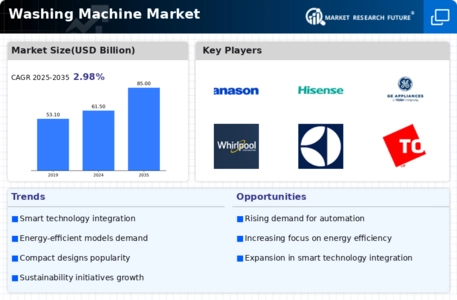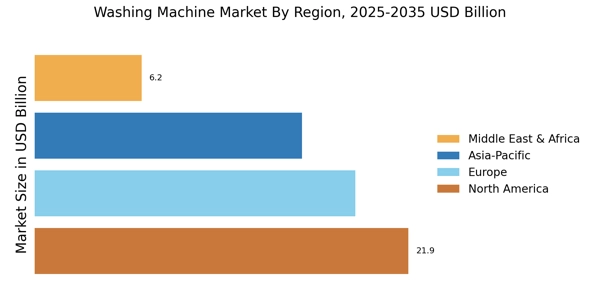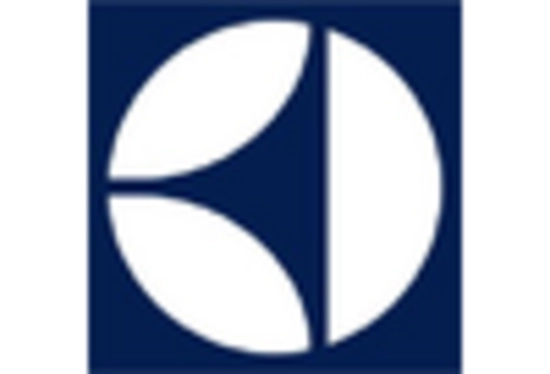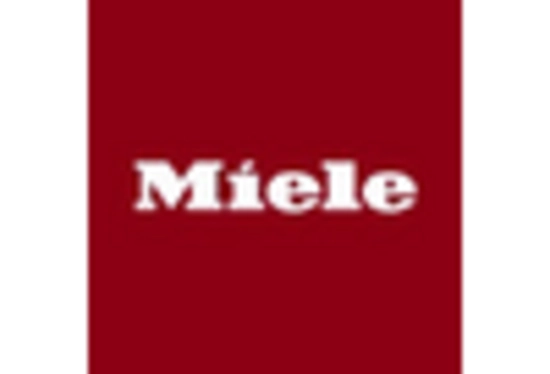The Washing Machine Market is currently characterized by a dynamic competitive landscape, driven by technological advancements, sustainability initiatives, and evolving consumer preferences. Major players such as Whirlpool (US), LG Electronics (KR), and Bosch (DE) are strategically positioned to leverage these trends. Whirlpool (US) focuses on innovation in energy-efficient appliances, while LG Electronics (KR) emphasizes smart technology integration, enhancing user experience through IoT capabilities. Bosch (DE), on the other hand, is committed to sustainability, aiming to reduce its carbon footprint through eco-friendly manufacturing processes. Collectively, these strategies not only enhance their market presence but also shape a competitive environment that increasingly prioritizes technological sophistication and environmental responsibility.
Key business tactics within the Washing Machine Market include localizing manufacturing and optimizing supply chains to enhance efficiency and responsiveness to market demands. The market structure appears moderately fragmented, with several key players exerting influence over various segments. This fragmentation allows for niche players to thrive, while larger corporations capitalize on economies of scale and brand recognition. The collective influence of these key players fosters a competitive atmosphere where innovation and customer-centric approaches are paramount.
In September 2025, LG Electronics (KR) announced the launch of its latest line of AI-powered washing machines, which utilize machine learning to optimize wash cycles based on fabric type and load size. This strategic move underscores LG's commitment to enhancing user convenience and energy efficiency, potentially setting a new standard in the market. The integration of AI not only differentiates LG's offerings but also aligns with the growing consumer demand for smart home solutions.
In August 2025, Bosch (DE) unveiled its new sustainability initiative aimed at achieving carbon neutrality in its manufacturing processes by 2026. This initiative reflects Bosch's proactive approach to environmental stewardship and positions the company favorably among eco-conscious consumers. By prioritizing sustainability, Bosch not only enhances its brand image but also addresses regulatory pressures and market expectations regarding environmental impact.
In July 2025, Whirlpool (US) entered a strategic partnership with a leading tech firm to develop a new range of connected appliances that integrate seamlessly with smart home ecosystems. This collaboration is indicative of Whirlpool's focus on digital transformation and its recognition of the growing importance of connectivity in consumer appliances. By enhancing its product offerings with smart technology, Whirlpool aims to capture a larger share of the tech-savvy consumer segment.
As of October 2025, the Washing Machine Market is witnessing trends that emphasize digitalization, sustainability, and the integration of artificial intelligence. Strategic alliances among key players are increasingly shaping the competitive landscape, fostering innovation and enhancing product offerings. The shift from price-based competition to a focus on technological advancement and supply chain reliability is evident, suggesting that future competitive differentiation will hinge on the ability to innovate and respond to consumer needs effectively.


















Leave a Comment